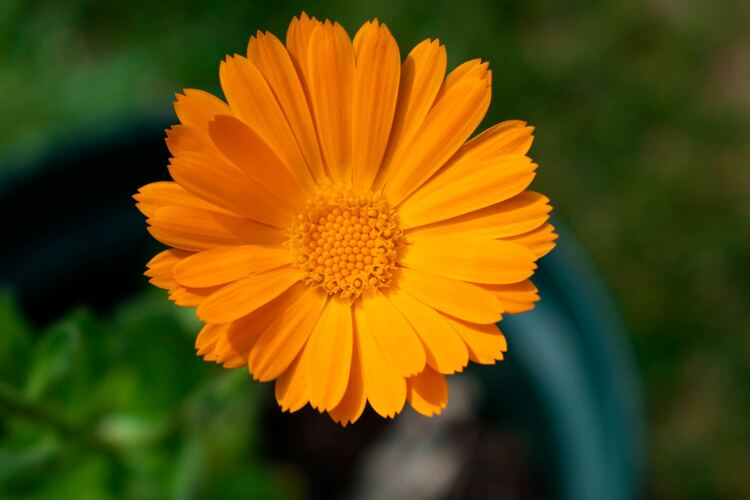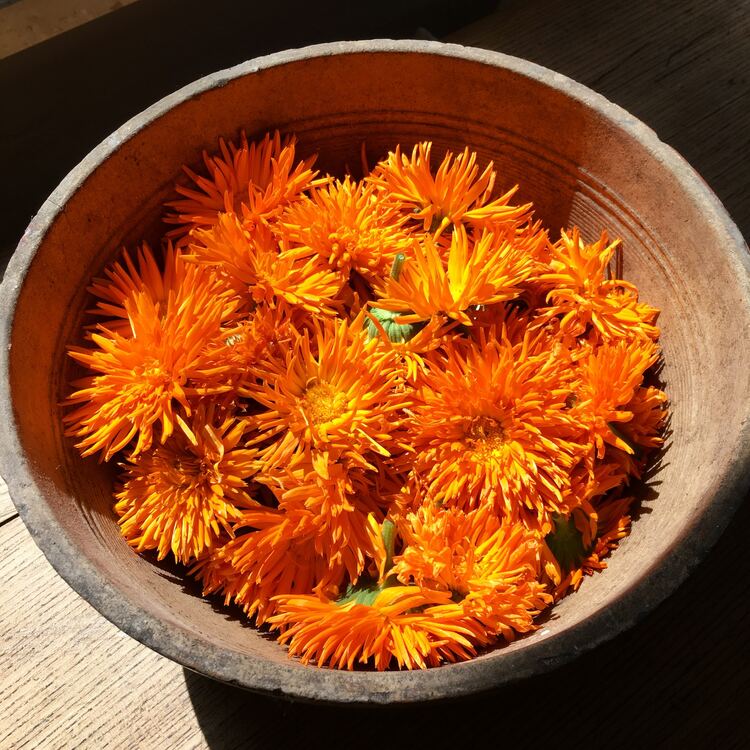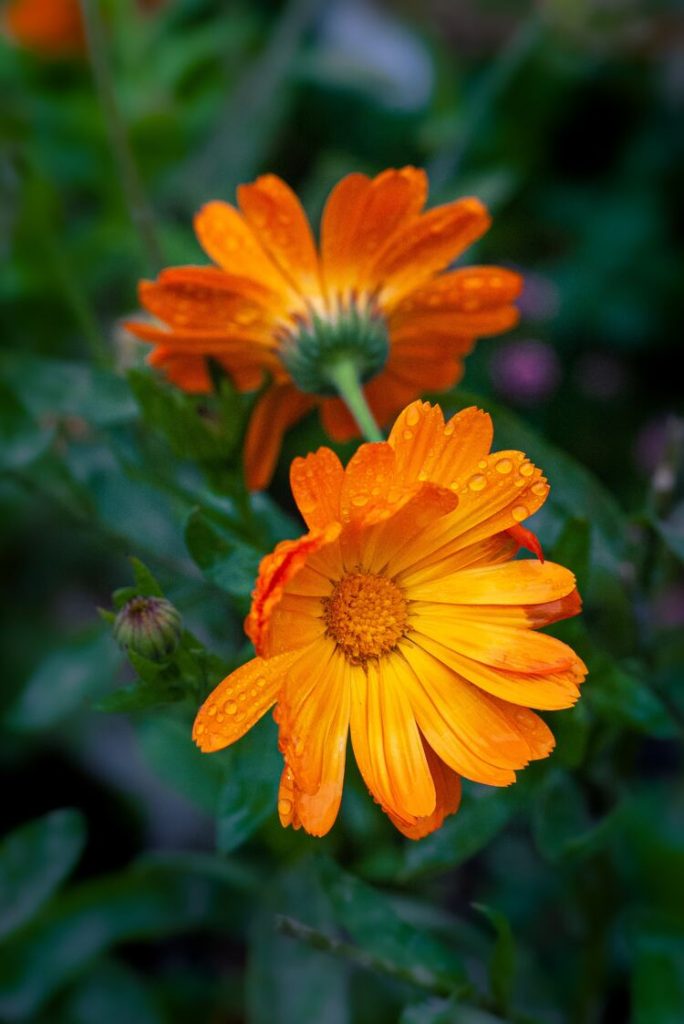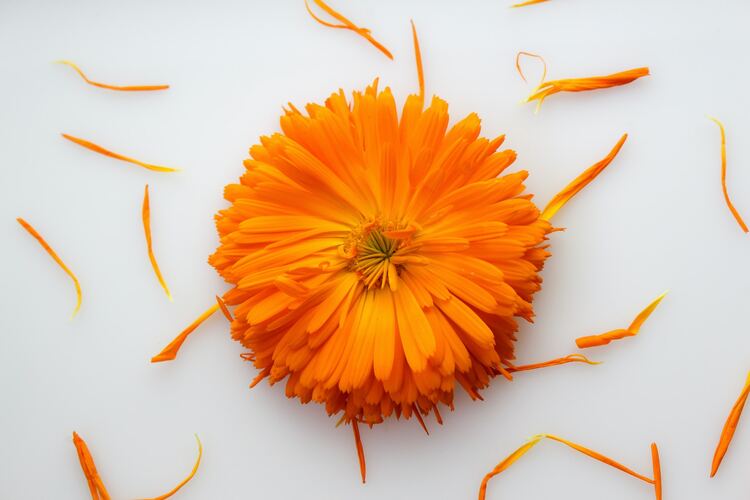In this article, we provide a calendula tea recipe. Also, we focus on serving/storage suggestions and health benefits.
Calendula tea, or marigold tea, is an incredibly versatile and flavorful beverage with numerous health benefits. Rich in antioxidants and anti-inflammatory properties, this soothing tea has been well-loved for centuries.
Keep reading to discover a simple calendula tea recipe that will soon become your go-to beverage for any time of day!
Please note: This article contains affiliate links, meaning I may earn a commission if you make a purchase by clicking a link. Of course, this comes at no extra cost to you and helps me keep offering readers solid information.

What is Calendula Tea?
Calendula tea is an herbal infusion made from the calendula officinalis plant’s dried petals, commonly known as marigold.
Calendula is a bright and cheerful flowering plant that is native to the Mediterranean region but is now grown in many parts of the world for its ornamental beauty and medicinal properties.
To clarify, Calendula refers to a genus (group) of plants. There are several species within that genus. Calendulas officinalis (marigold) is the most cultivated and used species of the genus.
And another clarification: the marigold used for this tea should not be confused with the Aztec or Mexican marigold (also known as cempasúchil or flor de muerto). This plant is native to the Americas.
Calendula Tea Recipe
To make a delicious cup of calendula tea, you’ll need the following ingredients:
- 1-2 tablespoons dried calendula flowers. Fresh or dried calendula will work, but dried calendula blossoms, petals, or flowers are recommended for a more concentrated flavor.
- 8-10 ounces of boiling water. For the best results, use purified or mineral-rich water to ensure the optimal taste.
- Sweetener (optional, to taste): While many people enjoy the subtle sweetness of calendula on its own, you might like to enhance it with a bit of honey, maple syrup, or even a splash of your favorite fruit juice. This will add a touch of natural sweetness and provide complementary flavors that bring out the best in your calendula tea.
- Lemon wedges, cucumber slices, fresh mint leaves (optional). These can be used as garnish to serve your tea.
Follow these simple instructions to brew your tea:
- Prepare your teapot: Start by warming your teapot with a little bit of boiling water. This helps to maintain the temperature of the tea while steeping. Empty the teapot and proceed to the next step.
- Measure the dried calendula flowers: Place 1-2 tablespoons of dried calendula flowers into the teapot. Adjust the amount based on your desired tea strength.
- Pour the boiling water: Carefully pour the boiling water into your teapot, submerging the calendula flowers completely. Place the lid on the teapot to help retain heat and allow for proper steeping.
- Steep the tea: Allow the tea to steep for 5-10 minutes, depending on your preferred taste. Remember that a longer steeping time will result in a stronger tea, while a shorter steep will yield a lighter flavor.
- Strain and serve: Once the steeping time is complete, pour the tea into your favorite mug or jar through a small strainer. This will remove the calendula flowers and give you a clear, smooth brew.
- Serve: Add a slice of lemon or honey (or sweetener of choice) for extra flavor (optional), and enjoy your warm, soothing drink. For a refreshing alternative, try serving it as iced tea. Allow the tea to cool down and pour it over ice, garnishing with mint leaves or cucumber slices for a delightful twist.
There you have it – a simple method for brewing calendula tea that you can enjoy anytime!
When storing your calendula tea, keeping it in the fridge will help preserve its freshness. For the best taste and nutritional benefits, consume the tea within 24 hours. If you’ve brewed a larger batch, store it in an airtight container in the fridge and use it within a few days. This convenient storage method ensures your tea is always ready to enjoy when needed.

Calendula Tea Recipe: Tips and Variations
Calendula tea can be blended with herbs, flowers, and spices to create unique and flavorful combinations. Here are some popular calendula tea blends:
Calendula and Chamomile Tea: Combining calendula with chamomile creates a soothing and mild herbal tea often used for relaxation and promoting sleep. It’s an excellent choice for winding down in the evening.
Calendula and Lavender Tea: This blend pairs calendula’s bright, sunny flavor with lavender’s calming and floral notes. It’s another excellent choice for a relaxing evening tea.
Calendula and Peppermint Tea: Mixing calendula with peppermint results in a refreshing and invigorating tea. The cool, minty flavor of peppermint complements the mild bitterness of calendula.
Calendula and Lemon Balm Tea: Lemon balm adds a citrusy and slightly tart note to calendula tea, creating a bright and uplifting infusion. This blend is often enjoyed for its refreshing qualities.
Calendula and Ginger Tea: Adding ginger to calendula tea gives it a spicy and warming kick. Ginger is known for its digestive properties and can add depth to flavor.
Calendula and Echinacea Tea: Combining calendula with echinacea creates an herbal tea that may be used to support the immune system. It’s a popular choice during cold and flu seasons.
Calendula and Green Tea: Mixing calendula with green tea adds a floral dimension to green tea’s grassy and vegetal notes. It’s a delightful blend for those who enjoy the antioxidant benefits of green tea.
Calendula and Rosehip Tea: This blend pairs calendula with rosehips, rich in vitamin C. It results in a slightly tart and fruity infusion high in antioxidants.
Calendula and Cinnamon Tea: Adding cinnamon to calendula tea creates a warm and spicy flavor profile. This blend is perfect for those who enjoy the comforting taste of cinnamon.
Calendula and Turmeric Tea: Combining calendula with turmeric creates a vibrant and earthy herbal tea. Turmeric is known for its potential anti-inflammatory properties.
When making these blends, you can adjust the ratios of the ingredients to suit your taste preferences.
Calendula in the Kitchen
Calendulas are vibrant and versatile edible flowers that can brighten up any dish. With their slightly tangy and peppery taste, these blossoms add a unique flavor to an array of dishes.
Salads and Garnishes: One great way to incorporate calendula into your recipes is by using the petals in salads. Simply pluck the petals from the flowers and sprinkle them throughout your salad mix. The bright yellow and orange hues bring a splash of color while adding a subtle flavor boost.
Oils and Vinegar: Infusing oils and vinegar with calendula petals is another excellent way to bring their unique taste to your cooking. To do this, add calendula petals to your choice of oil or vinegar and allow the infusion to sit for a few weeks. Once the petals have imparted their flavor, strain the liquid and use it in salad dressings, dips, or to flavor roasted vegetables and meats.
Herb Butter: Infusing softened butter with calendula petals is a creative way to add flavor to your dishes. This calendula-infused butter can enhance the taste of cooked vegetables, pasta, or bread.
Soups and Stews: Calendula petals can be used as a garnish for soups and stews, providing a burst of color and a subtle herbal flavor. They can also be stirred into the dish during the final stages of cooking.
Baking: Calendula petals can be used to decorate cakes, cupcakes, muffins, and cookies. They add a pop of color and an interesting texture to baked goods. You can also infuse calendula into sugar or make floral syrups for drizzling over desserts.
As you can see, incorporating calendula into your culinary repertoire offers various enticing possibilities. So, enjoy experimenting with this beautiful and flavorful flower in your kitchen!

Calendula Tea Health Benefits
Drinking calendula tea offers numerous health benefits for your body. One of the most prominent advantages is its anti-inflammatory properties. This soothing beverage can reduce inflammation, potentially alleviating pain and discomfort.
Calendula tea is also rich in antioxidants and carotenoids, which protect your cells from damage caused by free radicals. As your body ages, these powerful antioxidants can contribute to preserving your overall health and reduce aging signs.
In addition to its anti-inflammatory effects, calendula tea has antimicrobial and anti-fungal properties. These qualities help in strengthening your immune system and keeping infections at bay. Consuming calendula tea can be particularly beneficial for individuals with skin conditions such as eczema, as it may relieve itching and irritation.
If you’re dealing with a yeast infection, calendula tea may be a helpful natural remedy to ease your symptoms. Its anti-fungal properties can aid in combating the overgrowth of yeasts, reducing the uncomfortable effects associated with these infections.
Aside from the numerous health advantages for your body, calendula tea is a delicious and refreshing beverage. The vibrant floral taste and soothing warmth make it a perfect choice for a relaxing moment in your day.
How to Grow and Harvest Calendula
Growing calendula plants in your garden can provide endless flowers for all sorts of culinary uses. Here are some suggestions for those interested in growing these.
Choose a sunny spot with well-draining soil to add calendula to your garden. You can plant calendula seeds directly into the ground or start them in pots on a sunny windowsill. Once the risk of frost has passed, transplant the seedlings outdoors when they have a few true leaves. Space them about 8-12 inches apart in your herb garden.
Calendula prefers full sun but can tolerate light shade. Keep an eye on your plants and consistently water them during dry periods. Since calendula is a resilient herb, it can withstand occasional neglect in the garden.
As calendula flowers bloom in late spring or early summer, you can begin harvesting the fresh calendula blossoms. For the best results, harvest the petals while they are still fresh and vibrant, typically in the morning after the dew has evaporated. Make sure to leave the green base of the flower intact in order to prevent excessive wilting of the petals.
There are several ways to gather calendula petals; you can pinch them off with your thumb and forefinger or use scissors to cut the entire flower head off the plant. After harvesting, lay the fresh calendula flowers out to dry on a clean surface, away from direct sunlight. Once they are dehydrated, store them in an airtight container.
Fresh calendula flowers are often used in culinary applications but can also be dried and used later in the year. To prolong the blooming period, harvest calendula petals throughout the growing season. Deadhead spent flowers to encourage new blooms and prevent the plant from going to seed early.
Buying Recommendations
If you are interested in buying flowers for the calendula tea recipe presented in this article, please consider these recommendations:
Calendula Tea 1LB (16Oz) 100% CERTIFIED Organic

Eat Well Dried Calendula Flowers for Loose Leaf Tea

FGO Organic Calendula Flowers, Whole, 100% Raw From Egypt

Frequently Asked Questions
How do I prepare calendula tea?
You’ll need dried calendula flowers and boiling water to prepare calendula tea. Start by placing 1-2 teaspoons of dried flowers in a tea infuser or teapot. Pour 8 ounces of boiling water over the flowers and let it steep for 5-7 minutes. Strain the tea into a cup and enjoy. You can add honey or a slice of lemon for added flavor.
What are the health benefits of drinking calendula tea?
Calendula tea offers several health benefits. It is known for its anti-inflammatory properties and can help soothe digestive issues such as ulcers and gastritis. The tea may also boost the immune system and promote skin health. Some studies suggest that calendula tea has anti-cancer properties and can heal wounds. Remember to consult your healthcare professional before using calendula tea to remedy medical conditions.
Does calendula tea have any side effects?
While calendula tea is generally considered safe, some individuals might experience side effects such as an allergic reaction or skin irritation. If you’re pregnant or breastfeeding, it’s best to consult your healthcare provider before consuming calendula tea. Additionally, if you’re taking any medications, talk to your doctor to ensure no interactions with calendula tea.
What does calendula tea taste like?
Calendula tea has a mild, slightly sweet, and earthy flavor. Some people describe it as having hints of honey and a gentle floral taste. Since it’s not overpowering, you can easily customize it with your favorite sweeteners, herbs, or fruits.
Can I drink calendula tea daily?
Yes, you can drink calendula tea daily. However, paying attention to your body and adjusting your consumption is essential. If you notice any adverse effects or discomfort, reduce the frequency or stop drinking the tea altogether. As always, it is advisable to consult with your healthcare professional before making any significant changes to your daily health practices.
Where can I buy calendula tea?
You can purchase dried calendula flowers or pre-packaged calendula tea bags from health food stores, specialty tea shops, or online retailers. Choose a reputable supplier that offers organic, pesticide-free calendula to ensure the highest quality and safety.

I hope you have enjoyed the article and learned something new! See you next time!
Tell me, what do you think about this calendula tea recipe?
More About Flower Teas
What Does Jasmine Tea Taste Like?
What Does Hibiscus Tea Taste Like?
What Does Rose Tea Taste Like?